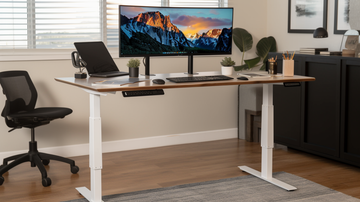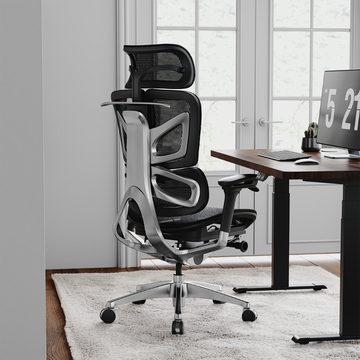A standing desk can be a game-changer for your workspace, promoting better posture and reducing the risks associated with a sedentary lifestyle. However, to truly reap the benefits of a standing desk, it's crucial to ensure it's set at the correct height. In this guide, we'll help you determine the ideal height for your standing desk to optimize comfort, productivity, and overall well-being.
-
Understand the basics of ergonomics: Ergonomics is the study of designing workspaces, tools, and equipment to fit the user's needs and promote efficiency and well-being. When it comes to standing desks, the primary ergonomic factors to consider are desk height, monitor height, keyboard and mouse placement, and proper footwear.
-
Measure your ideal standing desk height: To find the perfect height for your standing desk, follow these steps:
- Stand up straight with your shoulders relaxed and your feet hip-width apart.
- Bend your elbows at a 90-degree angle, with your forearms parallel to the ground.
- Measure the distance from the floor to your elbows. This measurement will give you an approximate desk height that promotes a neutral wrist posture and reduces strain on your shoulders and arms.
- Adjust your monitor height and position: The ideal monitor height and position can prevent neck and eye strain. To find the best placement for your monitor, follow these guidelines:
- Position the top of the monitor at or slightly below eye level.
- Ensure the monitor is placed at an arm's length distance from your eyes.
- Tilt the monitor screen slightly upward (around 20 degrees) to avoid glare and maintain a comfortable viewing angle.
- Position your keyboard and mouse correctly: Proper keyboard and mouse placement can prevent wrist strain and maintain a comfortable posture. Keep these tips in mind:
- Place the keyboard and mouse on the same surface, close to the edge of the desk.
- Ensure your wrists are in a neutral position, without bending upward or downward.
- Use a wrist rest or ergonomic keyboard to further reduce the risk of strain.
-
Choose the right footwear and anti-fatigue mat: Wearing comfortable, supportive footwear and using an anti-fatigue mat can make standing for extended periods more comfortable and reduce the stress on your legs and feet. Invest in a high-quality mat and choose shoes with good arch support and cushioning.
-
Listen to your body and make adjustments: Remember that individual preferences and body proportions vary, so it's important to listen to your body and adjust your standing desk height accordingly. If you experience discomfort or strain, make small adjustments to the desk or monitor height and observe how your body responds.
-
Don't forget to alternate between sitting and standing: While standing desks offer numerous benefits, it's essential to strike a balance between sitting and standing throughout the day. Experts recommend a sit-stand ratio of about 1:1 or 2:1, meaning for every hour of sitting, you should stand for 30 minutes to 1 hour. Investing in an adjustable standing desk can make transitioning between positions easy and efficient.
Conclusion: Determining the ideal standing desk height is essential for maximizing the ergonomic benefits and ensuring long-term comfort and productivity. By following the guidelines outlined in this comprehensive guide, you'll be well on your way to creating a healthier, more comfortable, and productive workspace. Remember to listen to your body, make adjustments as needed, and strike a balance between sitting and standing throughout the day.






